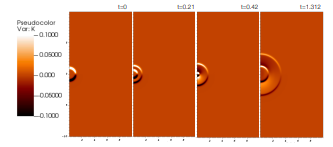2024-07-30 パシフィック・ノースウェスト国立研究所(PNNL)
<関連情報>
- https://www.pnnl.gov/publications/slab-ocean-model-shows-benefits-assessing-ocean-temperature-changes
- https://agupubs.onlinelibrary.wiley.com/doi/10.1029/2023MS003910
エネルギー・エクサスケール地球システムモデル(E3SM)のスラブ海洋コンポーネント: 開発、評価、地球システム感受性の理解への応用 Slab Ocean Component of the Energy Exascale Earth System Model (E3SM): Development, Evaluation, and Application to Understanding Earth System Sensitivity
Oluwayemi Garuba, Philip J. Rasch, L. Ruby Leung, Hailong Wang, Samson Hagos, Balwinder Singh
Journal of Advances in Modeling Earth Systems Published: 16 May 2024
DOI:https://doi.org/10.1029/2023MS003910

Abstract
This work describes the implementation and evaluation of the Slab Ocean Model component of the Energy Exascale Earth System Model version 2 (E3SMv2-SOM) and its application to understanding the climate sensitivity to ocean heat transports (OHTs) and CO2 forcing. E3SMv2-SOM reproduces the baseline climate and Equilibrium Climate Sensitivity (ECS) of the fully coupled E3SMv2 experiments reasonably well, with a pattern correlation close to 1 and a global mean bias of less than 1% of the fully coupled surface temperature and precipitation. Sea ice extent and volume are also well reproduced in the SOM. Consistent with general model behavior, the ECS estimated from the SOM (4.5 K) exceeds the effective climate sensitivity obtained from extrapolation to equilibrium in the fully coupled model (4.0 K). The E3SMv2 baseline climate also shows a large sensitivity to OHT strengths, with a global surface temperature difference of about 4.0°C between high-/low-OHT experiments with prescribed forcings derived from fully coupled experiments with realistic/weak ocean circulation strengths. Similar to their forcing pattern, the surface temperature response occurs mainly over the subpolar regions in both hemispheres. However, the Southern Ocean shows more surface temperature sensitivity to high/low-OHT forcing due to a positive/negative shortwave cloud radiative effect caused by decreases/increases in mid-latitude marine low-level clouds. This large temperature sensitivity also causes an overcompensation between the prescribed OHTs and atmosphere heat transports. The SOM’s ECS estimate is also sensitive to the prescribed OHT and the associated baseline climate it is initialized from; the high-OHT ECS is 0.5 K lower than the low-OHT ECS.
Key Points
- Slab Ocean Model implementation in E3SMv2 reproduces the model’s baseline climate and equilibrium climate sensitivity very well
- E3SMv2 Slab model experiments show a large surface temperature sensitivity to ocean heat transports, particularly in the Southern Hemisphere
- Temperature sensitivity to ocean heat transports is enhanced by the shortwave cloud radiative effect due to marine low-level cloud changes
Plain Language Summary
The implementation and evaluation of the Slab Ocean Model (SOM) in the Energy Exascale Earth System Model version 2 (E3SMv2) is described in this study. The SOM is evaluated by comparing its climate simulation to that of the full version of the model that uses a dynamic ocean model instead of a SOM. The SOM reproduces the baseline climate of the full E3SMv2, as well as the equilibrium surface global temperature response to CO2 doubling of the full model reasonably well. The SOM is further used to test the sensitivity of the E3SM model to various ocean heat transport strengths. The results show that E3SMv2 has a large surface temperature sensitivity to ocean heat transport changes, particularly over the Southern Ocean. This large sensitivity occurs due to changes in marine low-level clouds, which cause shortwave radiation changes that reach the surface and enhance the surface temperature changes. Atmosphere heat transport also responds to and compensates ocean heat transport changes, and as a result of the large temperature response in the Southern Ocean, this compensation is also greater there. We also find that increases in ocean heat transport reduce the equilibrium surface temperature response to CO2 doubling.



